We recommend control sprays and treatment intervals based on the number of pest moths collected in pheromone traps. Because large changes in pest density may occur, literally overnight, we suggest checking traps twice a week (more frequently if you prefer). By learning to identify your own trap catch, you can immediately respond to sudden changes in pest populations. Corn earworm and Fall armyworm are the best ones to monitor.
It is easy to identify the corn earworm and fall armyworm moths using this guide. With a little practice, anyone can become proficient. The first point to realize is that not all moths caught in your trap will be the target species. Other moths (as well as flies and bees, etc) fly into the trap. A few other moths actually respond to the pheromone, although usually not as strongly as the target species. Learning to identify your trap catch involves knowing your target species and distinguishing it from all others caught (size, shape, color, pattern).
Moths have two pairs of wings. The photo left shows moths with wings unspread, as you will find them in your traps. In some cases, seeing the hind wing is helpful, so you’ll move the front wings aside. Once you are familiar with identification, this should not be necessary.
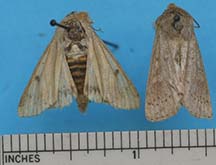
Moths Attracted to Hercon Corn Earworm Lures
Corn Earworm
Heliothis zea (Boddie) -
July through frost
Front wings are usually yellowish tan, but occasionally have a slight olive green or reddish brown cast. They usually have a half-rounded dark spot near the center. The hind wing is pale with a dark border. The border usually has a white median patch. Wingspan is about 1 ½ inches. These moths fly only at night. Heavily beat-up specimens will be harder to identify. Males and females look identical.
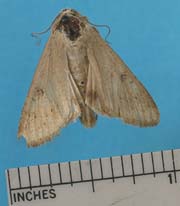
False Wainscott
Leucanis pseudargyria Gn -
June and July
These may outnumber earworms, especially in early summer. Front wing: brown or pinkish with a faint central spot; dark spots near edge are connected by a zigzag line. Hind wing: uniform dark. Front legs have a thick patch of fuzzy hair, and the tip of the abdomen is very large.
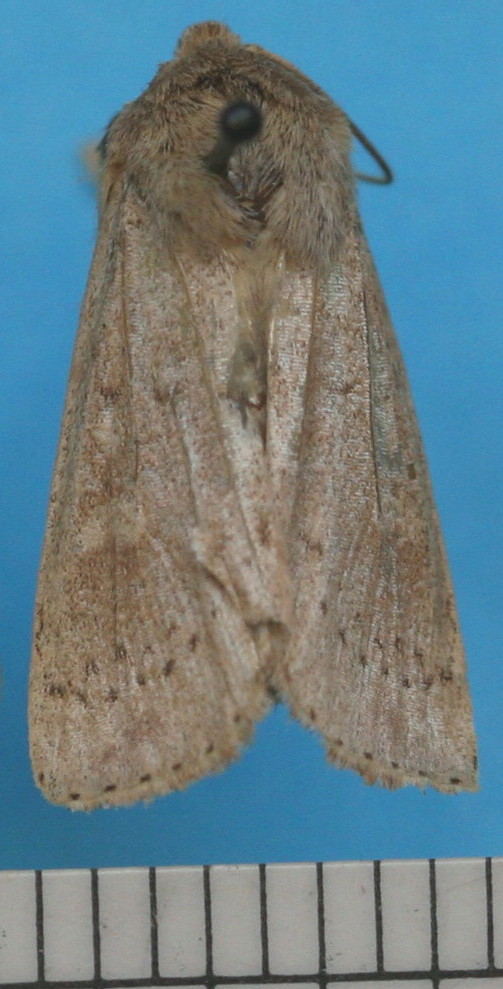
Common Armyworm
(not fall armyworm)
May to October- infrequently trapped
Front wing: tan to orange-tan, speckled with black, with a small white center dot and a slanting black line at the wing tip. Hind wing: light with a tan margin. Don’t confuse this common name with fall armyworm. This is Pseudaletia unipuncta…a different species. Their caterpillars sometimes attack corn, especially in June. There is no need to count them in the traps.
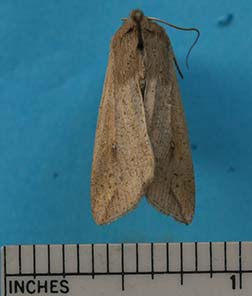
Gypsy Moth
Lymantria dispar (L.)
Late July through August
Front wing: brown with tan and black markings; dark band along border. Hind wing: brown with a dark border. Antennae are feather-like.
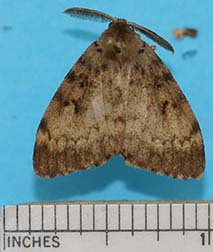
Moths Attracted to Fall Armyworm Pheromone
Traps (4- component lure)
Fall Armyworm
Spodoptera frugiperda J.E.Smith -
July to October
Front wing: gray to brown with a white wing bar extending about halfway across the middle of the wing; white spot at wing tip; wingspan about 1 to 1 ½ inches. Hind wing: white with a violet tinge. Females look quite different, but are not attracted to the pheromone traps. The photo at right shows a relatively fresh FAW specimen on the left, and a well worn specimen on the right. The white wing bar is just visible, although many of the other scales (that give the wing its color) are worn off.
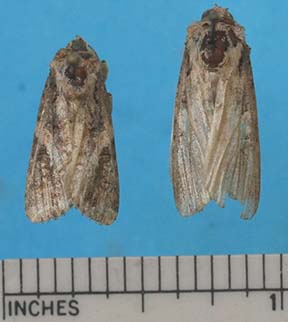
Phragmites Wainscott
Leucania phragmitidicola Gn. -
June and August
This moth is often trapped more frequently than fall armyworm. It is more common in the eastern part of the state, and is the same size as fall armyworm. Front wing: light colored and streaked with fine brown lines. A darker line runs up the center. Hind wing: light colored.
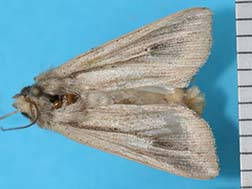
The Rosewing
Sideridis rosea Harr.
June through mid July
Front wing: light reddish brown, darker toward tips, with a dark spot near the middle. Hind wing: light colored.
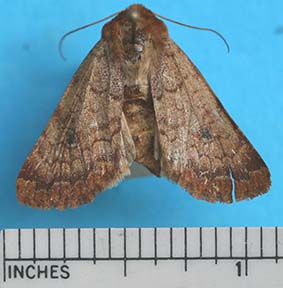
Moths Attracted to European Corn Borer Lures
We use lures [ECB-Iowa and ECB-NY] for both strains of corn borers that are in New Hampshire. The moths of both strains look identical. Compared to the light traps we formerly used, checking for European corn borers in pheromone traps is relatively easy. Although there are MANY species that look very similar, few of these are attracted to the lures.
Size and shape are especially important in identifying ECB.
European Corn Borer
Ostrinia nubilalis (Hubn)
Males are about 1 inch in wingspan, a dull grayish brown, with lighter markings. The shape of the wings is characteristic. At rest, they form a triangular outline. Females are pale, buff colored, but they will not be attracted to the pheromone traps. These moths sometimes fly about young corn plants during the day. The pheromone traps attract only males (left side of photo, below).
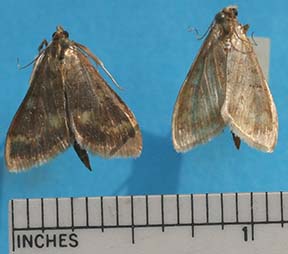
For details on the types of traps and lures to use, and setting up the traps, see “Setting Up Traps to Monitor Sweet Corn Insects in New Hampshire” by Alan Eaton.
This publication was supported in part by IPM grants from the New Hampshire Department of Agriculture, Markets and Food, and the National Institute for Food and Agriculture, United States Department of Agriculture.
Download the Resource for the complete fact sheet and a printable version.

